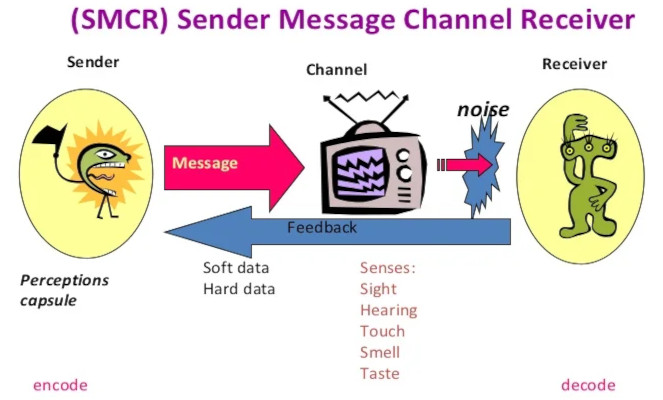Thruxion - Communication API
API URL: http://thruxion.com:3001/api/
Communication API allows to register all kind of messages between senders and receivers (humans and/or machines). The channel is the platform where the message travel to its destiny if a noise is registered it can be add to the log. the code is about the language of the message and it can be asociated to senses. It's possible to register the date and time or the geo-location of the messages but it's optional.

The documenatation has a beta programming languages implementation of the API. currently it's possible to choose between Shell, Ruby, Python and JavaScript.
Authentication
To authorize, use this code:
require 'net/http'
require 'json'
uri = URI('http://thruxion.com:3001/api/login')
req = Net::HTTP::Post.new(uri, 'Content-Type' => 'application/json')
req.body = { username: 'admin', password: 'yourpassword' }.to_json
res = Net::HTTP.start(uri.hostname, uri.port) { |http| http.request(req) }
puts res.body
import requests
url = "http://thruxion.com:3001/api/login"
data = {"username": "admin", "password": "yourpassword"}
response = requests.post(url, json=data)
print(response.json()) # Prints the token response
curl -X POST "http://thruxion.com:3001/api/login" \
-H "Content-Type: application/json" \
-d '{"username": "admin", "password": "yourpassword"}'
const axios = require('axios');
const login = async () => {
try {
const response = await axios.post('http://thruxion.com:3001/api/login', {
username: 'admin',
password: 'yourpassword'
});
console.log(response.data); // Prints the token response
} catch (error) {
console.error(error.response ? error.response.data : error.message);
}
};
login();
Make sure to replace with your own API credentials.
The API uses JSON Web Tokens (JWT) for stateless authentication. Users authenticate by logging in with their username and password. Upon successful authentication, a JWT token is generated and returned. This token must then be included in the Authorization header of subsequent requests to access protected endpoints.
The authentication process involves two steps:
Login: Submit your username and password to the /api/login endpoint to receive a JWT token
{ "username": "valid-provided-user", "password": "valid-provided-pass" }Authenticated Requests: Include the JWT token in the Authorization header as Bearer
for access to protected routes { "token": "eyJhbGcIU...I7MzBQ" }
HTTP Request
POST http://thruxion.com:3001/api/login
URL Parameters
| Parameter | Type |
|---|---|
| user | string |
| password | string |
Communications CRUD
Create Communication
require 'net/http'
require 'json'
require 'uri'
uri = URI("https://thruxion.com:3001/api/communication") # Updated URL to thruxion.com:3001
req = Net::HTTP::Post.new(uri, 'Content-Type' => 'application/json', 'Authorization' => 'Bearer YOUR_JWT_TOKEN')
# Example data to send
data = {
sender: 'sender_name',
receiver: 'receiver_name',
message: 'Hello, this is a test message',
channel: 'written',
noise: 'poor internet connection',
code: 'english',
feedback: 'delivered',
sense: 'eyes',
longitude: '123.4567',
latitude: '-123.4567',
date_time: '2025-01-01 00:00:00',
file_path: 'path/to/file/example.jpeg',
file: 'example.jpeg'
}
req.body = data.to_json
res = Net::HTTP.start(uri.hostname, uri.port, use_ssl: true) { |http| http.request(req) }
puts res.body
import requests
import json
url = "https://thruxion.com:3001/api/communication" # Updated URL to thruxion.com:3001
headers = {"Authorization": "Bearer YOUR_JWT_TOKEN", "Content-Type": "application/json"}
# Example data to send
data = {
"sender": "sender_name",
"receiver": "receiver_name",
"message": "Hello, this is a test message",
"channel": "email",
"noise": "poor internet connection",
"code": "english",
"feedback": "delivered",
"sense": "eyes",
"longitude": '123.4567',
"latitude": '-123.4567',
"date_time": '2025-01-01 00:00:00',
"file_path": 'path/to/file/example.jpeg',
"file": 'example.jpeg'
}
response = requests.post(url, headers=headers, json=data)
print(response.json()) # Prints the response message
curl -X POST "https://thruxion.com:3001/api/communication" \ # Updated URL to thruxion.com:3001
-H "Authorization: Bearer YOUR_JWT_TOKEN" \
-H "Content-Type: application/json" \
-d '{
"sender": "sender_name",
"receiver": "receiver_name",
"message": "Hello, this is a test message",
"channel": "email",
"noise": "poor internet connection",
"code": "english",
"feedback": "delivered",
"sense": "eyes",
"longitude": '123.4567',
"latitude": '-123.4567',
"date_time": '2025-01-01 00:00:00',
"file_path": 'path/to/file/example.jpeg',
"file": 'example.jpeg'
}'
const axios = require('axios');
const addCommunication = async (data, token) => {
try {
const response = await axios.post('https://thruxion.com:3001/api/communication', data, {
headers: { Authorization: `Bearer ${token}`, 'Content-Type': 'application/json' }
});
console.log(response.data); // Prints the response message
} catch (error) {
console.error(error.response ? error.response.data : error.message);
}
};
// Example data to send
const data = {
sender: 'sender_name',
receiver: 'receiver_name',
message: 'Hello, this is a test message',
channel: 'email',
noise: 'poor internet connection',
code: 'english',
feedback: 'delivered',
sense: 'eyes',
longitude: '123.4567',
latitude: '-123.4567',
date_time: '2025-01-01 00:00:00',
file_path: 'path/to/file/example.jpeg',
file: 'example.jpeg'
};
// Replace 'YOUR_JWT_TOKEN' with the actual token
addCommunication(data, 'YOUR_JWT_TOKEN');
The above command returns JSON structured like this:
[
{
"id": 2,
"message": "Communication record created successfully"
}
]
This endpoint add a new communication.
HTTP Request
POST http://thruxion.com:3001/api/communication
Parameters
| Parameter | Default | Description |
|---|---|---|
| sender | not null | who send the message |
| receiver | not null | who recieve the message |
| channel | not null | where the message travel |
| noise | null | possible interferences |
| code | not null | language of the message |
| message | not null | element exhanged |
| feedback | not null | response from the reciever |
| sense | null | senses involve in the message |
| longitude | null | geo-location (optional) |
| latitude | null | geo-location (optional) |
| date_time | null | when the message was sent |
| file_path | null | filepath where the message file is stored |
| file | file | New file to upload (optional) |
Update Communication
require 'net/http'
require 'json'
require 'uri'
uri = URI("https://thruxion.com:3001/api/communication/COMMUNICATION_ID") # Updated URL to thruxion.com:3001
req = Net::HTTP::Put.new(uri, 'Content-Type' => 'application/json', 'Authorization' => 'Bearer YOUR_JWT_TOKEN')
# Example data to update
data = {
sender: 'sender_name',
receiver: 'receiver_name',
message: 'Hello, this is a test message',
channel: 'written',
noise: 'internet poor connection',
code: 'english',
feedback: 'delivered',
sense: 'eyes'
}
req.body = data.to_json
res = Net::HTTP.start(uri.hostname, uri.port, use_ssl: true) { |http| http.request(req) }
puts res.body
import requests
import json
url = "https://thruxion.com:3001/api/communication/COMMUNICATION_ID" # Updated URL to thruxion.com:3001
headers = {"Authorization": "Bearer YOUR_JWT_TOKEN", "Content-Type": "application/json"}
# Example data to update
data = {
"sender": "updated_sender_name",
"receiver": "updated_receiver_name",
"message": "updated_message",
"channel": "email",
"noise": "internet poor connection",
"code": "english",
"feedback": "delivered",
"sense": "eyes"
}
response = requests.put(url, headers=headers, json=data)
print(response.json()) # Prints the response message
curl -X PUT "https://thruxion.com:3001/api/communication/COMMUNICATION_ID" \ # Updated URL to thruxion.com:3001
-H "Authorization: Bearer YOUR_JWT_TOKEN" \
-H "Content-Type: application/json" \
-d '{
"sender": "updated_sender_name",
"receiver": "updated_receiver_name",
"message": "Updated message content",
"channel": "email",
"noise": "internet poor connection",
"code": "english",
"feedback": "delivered",
"sense": "eyes"
}'
const axios = require('axios');
const updateCommunication = async (id, data, token) => {
try {
const response = await axios.put(`https://thruxion.com:3001/api/communication/${id}`, data, {
headers: { Authorization: `Bearer ${token}`, 'Content-Type': 'application/json' }
});
console.log(response.data); // Prints the response message
} catch (error) {
console.error(error.response ? error.response.data : error.message);
}
};
// Example data to update
const data = {
sender: 'sender_name',
receiver: 'receiver_name',
message: 'Hello, this is a test message',
channel: 'written',
noise: 'internet poor connection',
code: 'english',
feedback: 'delivered',
sense: 'eyes'
};
// Replace 'COMMUNICATION_ID' with the actual communication ID and 'YOUR_JWT_TOKEN' with the token
updateCommunication('COMMUNICATION_ID', data, 'YOUR_JWT_TOKEN');
The above command returns JSON structured like this:
{
"message": "Communication record updated successfully"
}
This endpoint update an existing communication.
HTTP Request
PUT http://thruxion.com:3001/api/communication/<ID>
Parameters
| Parameter | Default | Description |
|---|---|---|
| sender | not null | who send the message |
| receiver | not null | who recieve the message |
| channel | not null | where the message travel |
| noise | null | possible interferences |
| code | not null | language of the message |
| message | not null | element exhanged |
| feedback | not null | response from the reciever |
| sense | null | senses involve in the message |
Read All Communications
require 'net/http'
require 'json'
require 'uri'
uri = URI('https://thruxion.com:3001/api/communication') # Updated URL to thruxion.com
req = Net::HTTP::Get.new(uri, 'Authorization' => 'Bearer YOUR_JWT_TOKEN')
res = Net::HTTP.start(uri.hostname, uri.port, use_ssl: true) { |http| http.request(req) }
puts res.body
import requests
url = "https://thruxion.com:3001/api/communication" # Updated URL to thruxion.com
headers = {"Authorization": "Bearer YOUR_JWT_TOKEN"}
response = requests.get(url, headers=headers)
print(response.json()) # Prints all communications
curl "https://thruxion.com:3001/api/communication" \
-H "Authorization: Bearer YOUR_JWT_TOKEN"
const axios = require('axios');
const getAllCommunications = async (token) => {
try {
const response = await axios.get('https://thruxion.com:3001/api/communication', {
headers: { Authorization: `Bearer ${token}` }
});
console.log(response.data); // Prints all communications
} catch (error) {
console.error(error.response ? error.response.data : error.message);
}
};
// Replace 'YOUR_JWT_TOKEN' with the actual token
getAllCommunications('YOUR_JWT_TOKEN');
The above command returns JSON structured like this:
[
{
"id": 1,
"sender": "UserA",
"receiver": "UserB",
"channel": "Email",
"noise": "spam",
"code": "Spanish",
"message": "Hello, how are you?",
"feedback": "Sent",
"sense": "Visual",
"date_time": "2024-02-13T12:00:00.000Z",
"file_path": ""
},
{
"id": 2,
"sender": "Alice",
"receiver": "Bob",
"channel": "Zoom",
"noise": "None",
"code": "English",
"message": "Meeting file",
"feedback": "Delivered",
"sense": "Audiovisual",
"date_time": "2025-02-18T15:30:00.000Z",
"file_path": "/video/call.mp4"
}
]
This endpoint retrieves all communications.
HTTP Request
GET http://thruxion.com:3001/api/communication
Read Communication by ID
require 'net/http'
require 'json'
require 'uri'
communication_id = '1' # Replace with the ID of the communication you want to fetch
uri = URI("https://thruxion.com:3001/api/communication/#{communication_id}") # Updated URL to thruxion.com:3000
req = Net::HTTP::Get.new(uri, 'Authorization' => 'Bearer YOUR_JWT_TOKEN')
res = Net::HTTP.start(uri.hostname, uri.port, use_ssl: true) { |http| http.request(req) }
puts res.body
import requests
communication_id = '1' # Replace with the ID of the communication you want to fetch
url = f"https://thruxion.com:3001/api/communication/{communication_id}" # Updated URL to thruxion.com:3000
headers = {"Authorization": "Bearer YOUR_JWT_TOKEN"}
response = requests.get(url, headers=headers)
print(response.json()) # Prints the communication record
curl "https://thruxion.com:3001/api/communication/1" \ # Replace '1' with the actual communication ID
-H "Authorization: Bearer YOUR_JWT_TOKEN"
const axios = require('axios');
const getCommunicationById = async (id, token) => {
try {
const response = await axios.get(`https://thruxion.com:3001/api/communication/${id}`, {
headers: { Authorization: `Bearer ${token}` }
});
console.log(response.data); // Prints the communication record
} catch (error) {
console.error(error.response ? error.response.data : error.message);
}
};
// Replace '1' with the actual communication ID and 'YOUR_JWT_TOKEN' with the actual token
getCommunicationById('1', 'YOUR_JWT_TOKEN');
The above command returns JSON structured like this:
{
"id": 2,
"sender": "Alice",
"receiver": "Bob",
"channel": "Zoom",
"noise": "None",
"code": "English",
"message": "Meeting file",
"feedback": "Finished",
"sense": "Audiovisual",
"date_time": "2025-02-18T15:30:00.000Z",
"file_path": "/video/call.mp4"
}
This endpoint retrieves a specific communication.
HTTP Request
GET http://thruxion.com:3001/api/communication/<ID>
Parameters
| Parameter | Description |
|---|---|
| ID | Communicaton ID |
Delete Communication
require 'net/http'
require 'json'
require 'uri'
uri = URI('http://thruxion.com:3001/api/communication/1') # Replace '1' with the ID of the record you want to delete
req = Net::HTTP::Delete.new(uri, 'Authorization' => 'Bearer YOUR_JWT_TOKEN')
res = Net::HTTP.start(uri.hostname, uri.port) { |http| http.request(req) }
puts res.body
import requests
url = "http://thruxion.com:3001/api/communication/1" # Replace '1' with the ID of the record you want to delete
headers = {"Authorization": "Bearer YOUR_JWT_TOKEN"}
response = requests.delete(url, headers=headers)
print(response.json()) # Prints the response after deletion
curl -X DELETE "http://thruxion.com:3001/api/communication/1" \
-H "Authorization: Bearer YOUR_JWT_TOKEN"
const axios = require('axios');
const deleteCommunication = async (id, token) => {
try {
const response = await axios.delete(`http://thruxion.com:3001/api/communication/${id}`, {
headers: { Authorization: `Bearer ${token}` }
});
console.log(response.data); // Prints the response after deletion
} catch (error) {
console.error(error.response ? error.response.data : error.message);
}
};
// Replace '1' with the ID and 'YOUR_JWT_TOKEN' with the actual token
deleteCommunication(1, 'YOUR_JWT_TOKEN');
The above command returns JSON structured like this:
{
"message": "Communication record deleted successfully"
}
This endpoint deletes a specific communication.
HTTP Request
DELETE http://thruxion.com:3001/api/communication/<ID>
Parameters
| Parameter | Description |
|---|---|
| ID | Communication ID |
Errors
The Communication API uses the following error codes:
| Error Code | Meaning |
|---|---|
| 400 | Bad Request -- Your request is invalid. |
| 401 | Unauthorized -- Your API key is wrong. |
| 403 | Forbidden -- The kitten requested is hidden for administrators only. |
| 404 | Not Found -- The specified kitten could not be found. |
| 405 | Method Not Allowed -- You tried to access a communication with an invalid method. |
| 406 | Not Acceptable -- You requested a format that isn't json. |
| 410 | Gone -- The communication requested has been removed from our servers. |
| 429 | Too Many Requests -- You're requesting too many communications! Slow down! |
| 500 | Internal Server Error -- We had a problem with our server. Try again later. |
| 503 | Service Unavailable -- We're temporarily offline for maintenance. Please try again later. |

